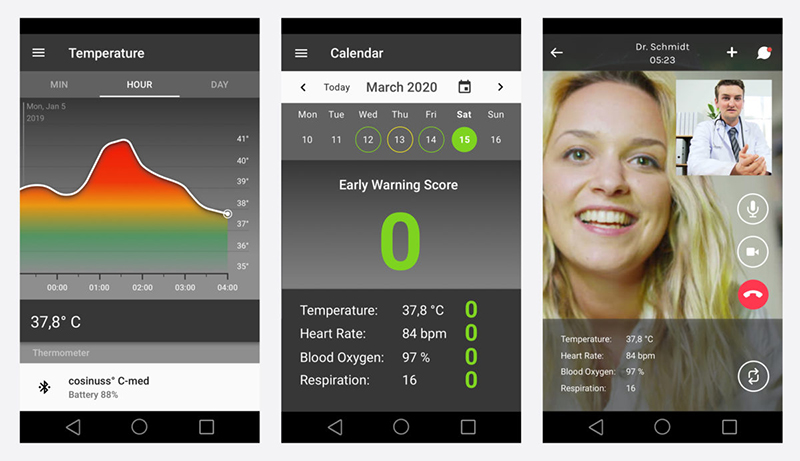cosinuss, who’s a good partner of us and will exhibit at the WT | Wearable Technologies Show MEDICA on November 16-19, is proposing a medical home monitoring solution, primarily reaching out to low and medium risk patients of COVID-19 who are in home isolation. The monitoring system, presented by the German company who recently got certified by TÜV SÜD, consists of an in-ear wearable sensor (cosinuss° C-med), a mobile device application (cosinuss° LabApp) and a server database (cosinuss° LabServer). Advanced algorithms digitally evaluate the health status based on the continuous measurement of key physiological vital parameters – independent of the person’s location:
- Core body temperature
- Heart rate
- Blood oxygen saturation
- Respiration rate
Benefits of the cosinuss mobile monitoring of vital parameters in combination with telemedicine for Covid-19 patients:
- Continuous remote patient monitoring in home isolation
- Better risk assessment for patients and healthcare professionals
- Optimally running hospitals and testing labs, in accordance with their capacities
- Accurate data basis for early medical studies
The current COVID-19 crisis has hit the healthcare system which is in danger of not having enough capacity to treat health problems that are not related with COVID-19. 80% of all the people going to an emergency room or seeking doctors could be monitored or treated at home to secure resources for those in urgent need, reports cosinuss.
cosinuss Remote Home Monitoring Solution
Remote patient monitoring
Each patient will be equipped with a cosinuss° Two in-ear wearable sensor, which they should wear a minimum of 4 hours a day. The measurements will be received via Bluetooth by the cosinuss° LabApp, installed on the patient’s smartphone.
Vital sign analytics
All personal health data on the cosinuss° LabServer is pseudonymized. The real-time vital signs will be visualized and stored in a server database. This data is evidence for advanced early warning algorithms such as EWS or Polyscore that evaluate the urgency of intervention or hospitalization.
Healthcare data access
Access is provided throughout the simple cosinuss° LabInterface that can be used by hospitals or health authorities simply using a web browser and the correct Login authorization. Using an Application Programming Interface (API) the data can be directly integrated into Telemedicine platforms and video calls. Additionally, in the future, the data can be seamlessly integrated into the databases of diverse clinical studies on COVID-19.
Read more Cosinuss One Now Provides You New Possibilities with Update for Swimming

cosinuss Two
The cosinuss° Two is a one-of-its-kind wearable enabling mobile medical-grade vital sign monitoring for home health use. The patented measurement technology continuously monitors 4 of the 5 key vital signs in a non-invasive way: Core Body Temperature, Heart Rate, Blood Oxygen Saturation and Respiration Rate. The cosinuss° Two combines an optical photoplethysmography (PPG) sensor (using standard components: LED and photo-diode), an infrared or contact temperature sensor and a 3D-axis accelerometer.
cosinuss Lab App
The cosinuss° LabApp is a smartphone application for Android and iOS downloadable from the common App Stores. It enables the smartphone to receive and store the sensor data that is transferred via Bluetooth. The LabApp itself acts as a gateway to transmit the data stream onto the cosinuss° LabServer.
Early Warning Algorithms
As soon as an early warning score threshold is triggered the patient and the medical staff in charge will be notified throughout cosinuss° LabApp and the cosinuss° LabInterface online. Then the patient can be securely contacted and informed about the next steps, which might be hospitalization for example.












